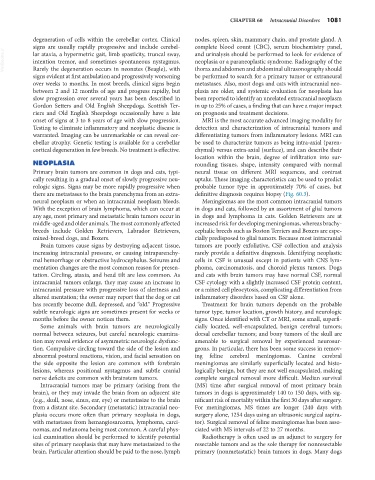Page 1109 - Small Animal Internal Medicine, 6th Edition
P. 1109
CHAPTER 60 Intracranial Disorders 1081
degeneration of cells within the cerebellar cortex. Clinical nodes, spleen, skin, mammary chain, and prostate gland. A
signs are usually rapidly progressive and include cerebel- complete blood count (CBC), serum biochemistry panel,
VetBooks.ir lar ataxia, a hypermetric gait, limb spasticity, truncal sway, and urinalysis should be performed to look for evidence of
neoplasia or a paraneoplastic syndrome. Radiography of the
intention tremor, and sometimes spontaneous nystagmus.
Rarely the degeneration occurs in neonates (Beagle), with
be performed to search for a primary tumor or extraneural
signs evident at first ambulation and progressively worsening thorax and abdomen and abdominal ultrasonography should
over weeks to months. In most breeds, clinical signs begin metastases. Also, most dogs and cats with intracranial neo-
between 2 and 12 months of age and progress rapidly, but plasia are older, and systemic evaluation for neoplasia has
slow progression over several years has been described in been reported to identify an unrelated extracranial neoplasm
Gordon Setters and Old English Sheepdogs. Scottish Ter- in up to 25% of cases, a finding that can have a major impact
riers and Old English Sheepdogs occasionally have a late on prognosis and treatment decisions.
onset of signs at 3 to 8 years of age with slow progression. MRI is the most accurate advanced imaging modality for
Testing to eliminate inflammatory and neoplastic disease is detection and characterization of intracranial tumors and
warranted. Imaging can be unremarkable or can reveal cer- differentiating tumors from inflammatory lesions. MRI can
ebellar atrophy. Genetic testing is available for a cerebellar be used to characterize tumors as being intra-axial (paren-
cortical degeneration in few breeds. No treatment is effective. chymal) versus extra-axial (surface), and can describe their
location within the brain, degree of infiltration into sur-
NEOPLASIA rounding tissues, shape, intensity compared with normal
Primary brain tumors are common in dogs and cats, typi- neural tissue on different MRI sequences, and contrast
cally resulting in a gradual onset of slowly progressive neu- uptake. These imaging characteristics can be used to predict
rologic signs. Signs may be more rapidly progressive when probable tumor type in approximately 70% of cases, but
there are metastases to the brain parenchyma from an extra- definitive diagnosis requires biopsy (Fig. 60.3).
neural neoplasm or when an intracranial neoplasm bleeds. Meningiomas are the most common intracranial tumors
With the exception of brain lymphoma, which can occur at in dogs and cats, followed by an assortment of glial tumors
any age, most primary and metastatic brain tumors occur in in dogs and lymphoma in cats. Golden Retrievers are at
middle-aged and older animals. The most commonly affected increased risk for developing meningiomas, whereas brachy-
breeds include Golden Retrievers, Labrador Retrievers, cephalic breeds such as Boston Terriers and Boxers are espe-
mixed-breed dogs, and Boxers. cially predisposed to glial tumors. Because most intracranial
Brain tumors cause signs by destroying adjacent tissue, tumors are poorly exfoliative, CSF collection and analysis
increasing intracranial pressure, or causing intraparenchy- rarely provide a definitive diagnosis. Identifying neoplastic
mal hemorrhage or obstructive hydrocephalus. Seizures and cells in CSF is unusual except in patients with CNS lym-
mentation changes are the most common reason for presen- phoma, carcinomatosis, and choroid plexus tumors. Dogs
tation. Circling, ataxia, and head tilt are less common. As and cats with brain tumors may have normal CSF, normal
intracranial tumors enlarge, they may cause an increase in CSF cytology with a slightly increased CSF protein content,
intracranial pressure with progressive loss of alertness and or a mixed cell pleocytosis, complicating differentiation from
altered mentation; the owner may report that the dog or cat inflammatory disorders based on CSF alone.
has recently become dull, depressed, and “old.” Progressive Treatment for brain tumors depends on the probable
subtle neurologic signs are sometimes present for weeks or tumor type, tumor location, growth history, and neurologic
months before the owner notices them. signs. Once identified with CT or MRI, some small, superfi-
Some animals with brain tumors are neurologically cially located, well-encapsulated, benign cerebral tumors;
normal between seizures, but careful neurologic examina- dorsal cerebellar tumors; and bony tumors of the skull are
tion may reveal evidence of asymmetric neurologic dysfunc- amenable to surgical removal by experienced neurosur-
tion. Compulsive circling toward the side of the lesion and geons. In particular, there has been some success in remov-
abnormal postural reactions, vision, and facial sensation on ing feline cerebral meningiomas. Canine cerebral
the side opposite the lesion are common with forebrain meningiomas are similarly superficially located and histo-
lesions, whereas positional nystagmus and subtle cranial logically benign, but they are not well encapsulated, making
nerve deficits are common with brainstem tumors. complete surgical removal more difficult. Median survival
Intracranial tumors may be primary (arising from the (MS) time after surgical removal of most primary brain
brain), or they may invade the brain from an adjacent site tumors in dogs is approximately 140 to 150 days, with sig-
(e.g., skull, nose, sinus, ear, eye) or metastasize to the brain nificant risk of mortality within the first 30 days after surgery.
from a distant site. Secondary (metastatic) intracranial neo- For meningiomas, MS times are longer (240 days with
plasia occurs more often than primary neoplasia in dogs, surgery alone, 1254 days using an ultrasonic surgical aspira-
with metastases from hemangiosarcoma, lymphoma, carci- tor). Surgical removal of feline meningiomas has been asso-
nomas, and melanoma being most common. A careful phys- ciated with MS intervals of 22 to 27 months.
ical examination should be performed to identify potential Radiotherapy is often used as an adjunct to surgery for
sites of primary neoplasia that may have metastasized to the resectable tumors and as the sole therapy for nonresectable
brain. Particular attention should be paid to the nose, lymph primary (nonmetastatic) brain tumors in dogs. Many dogs

